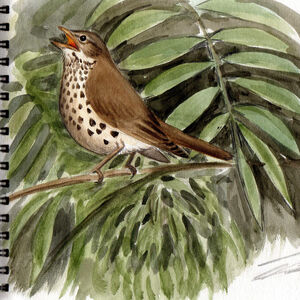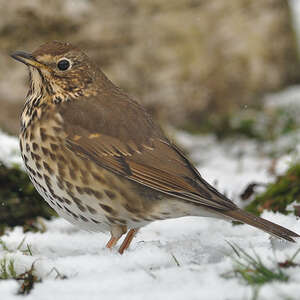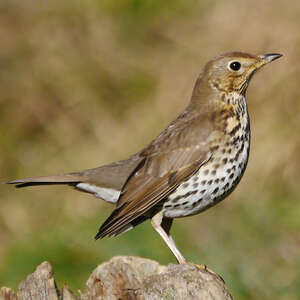Song Thrush
Turdus philomelos - Grive musicienne
Identification
The Song Thrush is slightly smaller than the Blackbird which it often shares a habitat with, but there is no danger of confusing the two. It is a bulkier bird, with a shorter tail and lighter plumage. The upper parts are of a fairly warm brown and fairly uniform in appearance. A ruddy tinge can be seen on the crown and wings, while the lower back, rump and upper tail-coverts seem a little greyer. The dark eye is ringed by paleness, giving it a larger than life appearance. The rufous eyebrow is barely visible, which distinguishes it from its cousin the Mistle Thrush. The ear-coverts are rufous and surrounded by a brown hue; finally, the sharply black malar stripes come together beneath the throat to form a kind of mottled collar. The underparts are rufous on the chest and flanks and white-cream on the belly, with blackish-brown V or heart-shaped spots scattered over the chest, upper belly and flanks. The legs are pink and the beak is brownish with a yellow base to the lower mandible. In flight, pale orange underwings can be distinguished. The juvenile can be distinguished from the adult by its warmer brown plumage and particularly by the rufous patches of the mantle, scapulars, median and greater coverts. The rufous tips to the coverts will remain after juvenile moult, still visible until the bird's second year. As for the potential confusion with the Fieldfare, a dilemma often faced by the beginner ornithologist, it should be noted that the Fieldfare is larger (even larger than the Blackbird), with a duller, grayer hue and a more segmented (tertials and coverts with pale edges) upper plumage, and lighter undersides with larger, more numerous (also on the belly) and differently shaped spots.Its long tail is marked with white on the outer rectrices. Its pale ear coverts are surrounded by a darker brown pattern, often forming two dark bars on the side of the head. In flight, the undertail feathers appear very white. Finally, the rolling calls are very different.
Subspecific information 4 subspecies
- Turdus philomelos philomelos (Europe. except w. , n Turkey, the Caucasus and n Iran)
- Turdus philomelos hebridensis (Outer Hebrides, I. of Skye, w Scotland and w Ireland)
- Turdus philomelos clarkei (w Europe)
- Turdus philomelos nataliae (w and c Siberia)
Foreign names
- Grive musicienne,
- Zorzal común,
- tordo-pinto,
- Singdrossel,
- énekes rigó,
- Zanglijster,
- Tordo bottaccio,
- taltrast,
- Måltrost,
- drozd plavý,
- drozd zpěvný,
- Sangdrossel,
- laulurastas,
- tord comú,
- Söngþröstur,
- (drozd) śpiewak,
- dziedātājstrazds,
- cikovt,
- Певчий дрозд,
- ウタツグミ,
- 欧歌鸫,
- taltrast,
- 歌鶇,
Voice song and call
The contact call is a sharp and incisive sip that is similar to the call of some buntings like the Long-Spurred Bunting. It is often emitted at take-off when the bird is disturbed, and it is this call that is uttered by the night migrants, thereby maintaining contact between them. The alarm call is a rapid repetition of hard notes té dé dé det, but it doesn't have the metallic tone of the similar call of the Blackbird. The song is a sequence of varied, clear and powerful notes, whistled or flutted, high-pitched and well-defined. But above all, these notes are repeated several times (2 to 6 generally) and it is this repetition that makes the Song Thrush's song so typical.
Habitat
The Song Thrush is a forest breeding species. It is not picky about habitat, which allows it to inhabit many different forest features, deciduous, coniferous or mixed, ranging from plains to high altitudes.
Behaviour character trait
The Song Thrush is a common species. However, it is a discreet and stealthy bird, very fearful most of the time. Close observation is not easy as it flees at the slightest alert. However, during the singing period, some males, entirely due to their territoriality, become more confident and allow themselves to be approached. The species is not really gregarious like the Lesser Whitethroat or the Yellowhammer can be. However, at the peak of migration, it can be observed in loose groups of up to a few dozen individuals, particularly when weather conditions cause a migration block.
It often associates with its congeners Lesser Whitethroat and Yellowhammer during migration period. It can even be seen on the lawns of urban parks and private gardens during this period. It searches for food on the ground where it progresses by small jumps. In case of danger, it flies to hide in woody places where it can remain motionless for a long time waiting for peace to return. During the inter-season, it looks for fruits in bushes and hedges. It has made a specialty of small snails like hedge snails that it extracts from their shell in its own way. Holding the mollusk in its beak, it strikes it violently against a stone or another solid substrate forming an anvil until it is free from its shell, then consumes it. These places are regularly frequented throughout the fine season. That is why it is common in nature to observe these small piles of shell debris marking its presence. The Song Thrush is very territorial during the nesting period. Despite this, density in the most favourable areas can reach 50 couples per km². The male vocally affirms his territory. He often sings perched in prominence at the top of a tree, for example a conifer, in order to survey his territory.As with other thrushes, crepuscular vocal activity is intense. It is, along with blackbird and robin, one of the woodland birds that sing the latest in the evening and the earliest in the morning. The Song Thrush is a partial migrant. It is all the more prone to migratory movements since its populations are northern. It migrates at night, marking its passage with its sharp sip.Flight
The Song Thrush has long wings that allow it to make long migratory journeys. Fast and powerful wingbeats allow for easy take-off and continuous flight. Migrating birds usually fly quite high at night. In the morning, the birds that stop to rest plunge at full speed to the trees that will provide them with safety.
Dietfeeding habits
The Song Thrush's diet is very varied. It consumes many invertebrates, particularly arthropods (insects and their larvae, myriapods, and terrestrial crustaceans), oligochaetes, and mollusks (little snails that it breaks the shell of). During the inter-nuptial period, the diet diversifies and includes many berries (ivy, juniper, sea-buckthorn, etc.) still on the shrub or on the ground.
Reproduction nesting
The Song Thrush's nest is typically built at an average height of 2 to 3 meters (0 to 9 m) in woody vegetation.
At the beginning of the season, before deciduous trees take root in the plains, it is often built in a coniferous tree. Later, a dense deciduous tree will serve its purpose. The nest is made of dry grasses, straws and moss. The interior is lined with a smooth mortar made of a mixture of mud and compressed dead wood fibers, giving it a characteristic, clear look. The female lays 3 to 5 eggs (average of 4) with a bright blue-green color with a few rare, brown-black spots. Incubation typically lasts 13 days. The nestlings are nidicolous. Both parents feed them and they leave the nest at 12 to 15 days. The parents still protect and feed them for 2 to 3 weeks. The average success rate of the fledging has been calculated at 55%.Geographic range
The Song Thrush's breeding range extends across all of temperate Europe, including the British Isles, and extends eastward into Siberia to Lake Baikal. The species ranges as far north as the Scandinavia peninsula. The southern limit passes through northern Spain, Italy, Greece, Turkey, and reaches the south part of the Caspian Sea in Iran. The Song Thrush is a partial migrant. The birds in the British Isles and France are partly sedentary. The main wintering areas are in the Mediterranean climate around the Mediterranean (Spain, Italy, Maghreb, southern Turkey, Middle East), the Red Sea, and the Persian Gulf (particularly Iran).
Threats - protection
IUCN conservation status
concern
in the Wild
threatened
evaluated
The Song Thrush is broadly spread. It is a common to very common species in its area, and as a result not threatened. Nevertheless, it must be noted that this bird is subject to intense hunting, legal or not, in most Mediterranean countries and that its status could evolve unfavorably in the future, taking into account also the already perceptible climate changes.
Sources of information
- IOC World Bird List (v14.2), Gill, F and D Donsker (Eds). 2024-04-18.
- xeno-canto, Sharing bird sounds from around the world,
- Avibase, Lepage Denis
- HBW Alive,
Other sources of interest
 Specification sheet created on
07/07/2023 by Jean François
Specification sheet created on
07/07/2023 by Jean FrançoisTranslation by AI Oiseaux.net
© 1996-2025 Oiseaux.net
- Accipitriformes
- Aegotheliformes
- Anseriformes
- Apodiformes
- Apterygiformes
- Bucerotiformes
- Caprimulgiformes
- Cariamiformes
- Casuariiformes
- Charadriiformes
- Ciconiiformes
- Coliiformes
- Columbiformes
- Coraciiformes
- Cuculiformes
- Eurypygiformes
- Falconiformes
- Galliformes
- Gaviiformes
- Gruiformes
- Leptosomiformes
- Mesitornithiformes
- Musophagiformes
- Nyctibiiformes
- Opisthocomiformes
- Otidiformes
- Passeriformes
- Pelecaniformes
- Phaethontiformes
- Phoenicopteriformes
- Piciformes
- Podargiformes
- Podicipediformes
- Procellariiformes
- Psittaciformes
- Pterocliformes
- Rheiformes
- Sphenisciformes
- Steatornithiformes
- Strigiformes
- Struthioniformes
- Suliformes
- Tinamiformes
- Trogoniformes

































